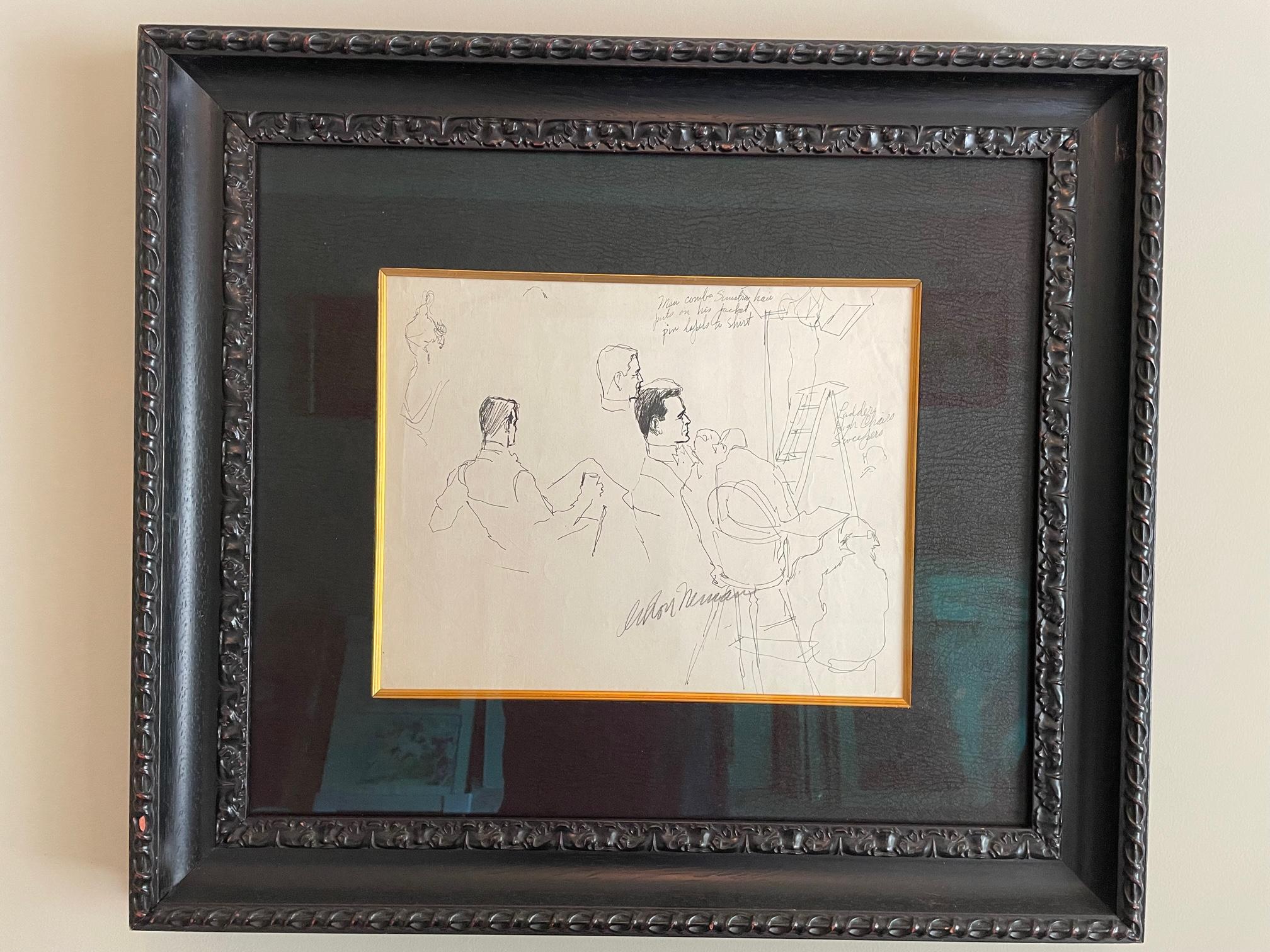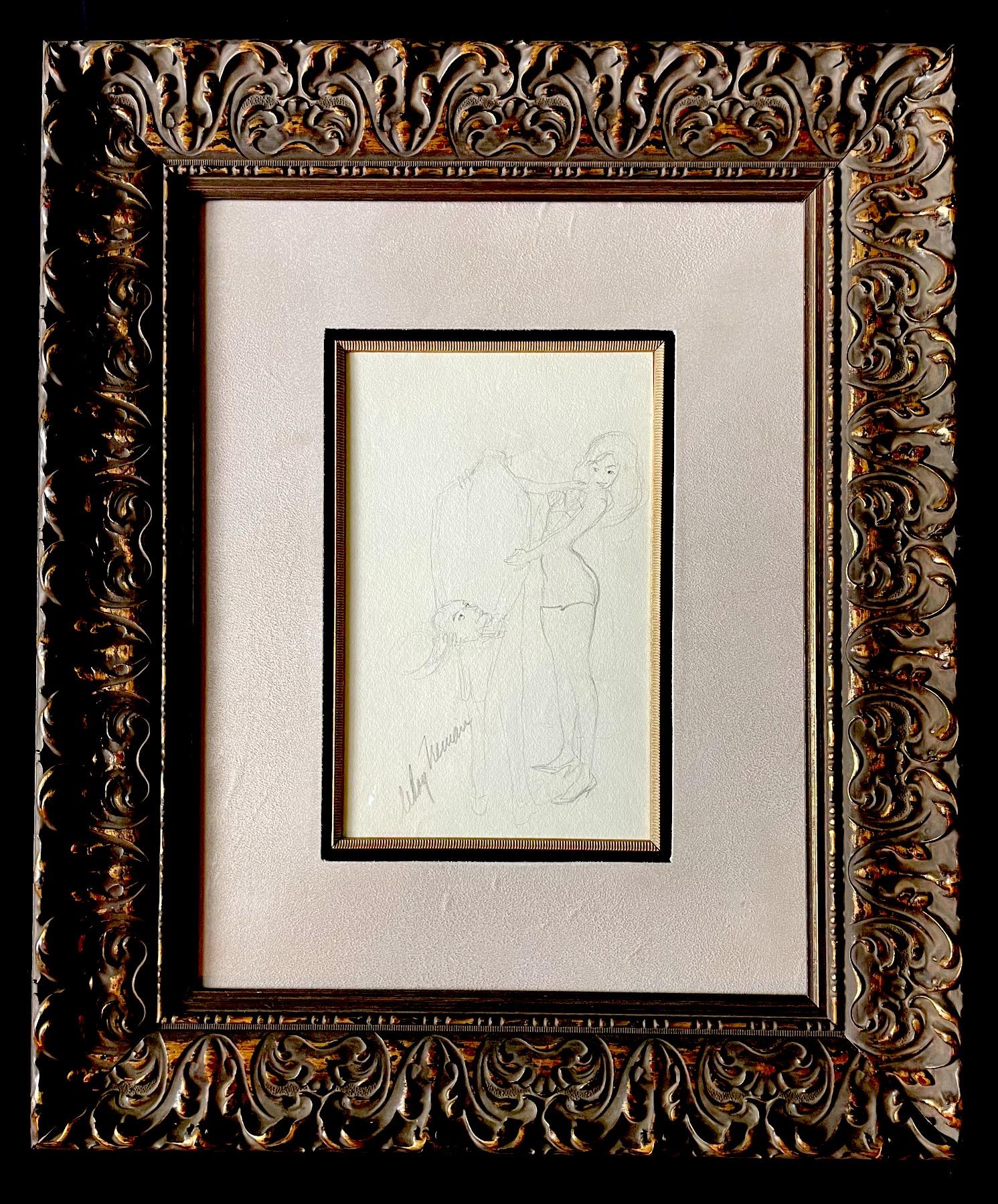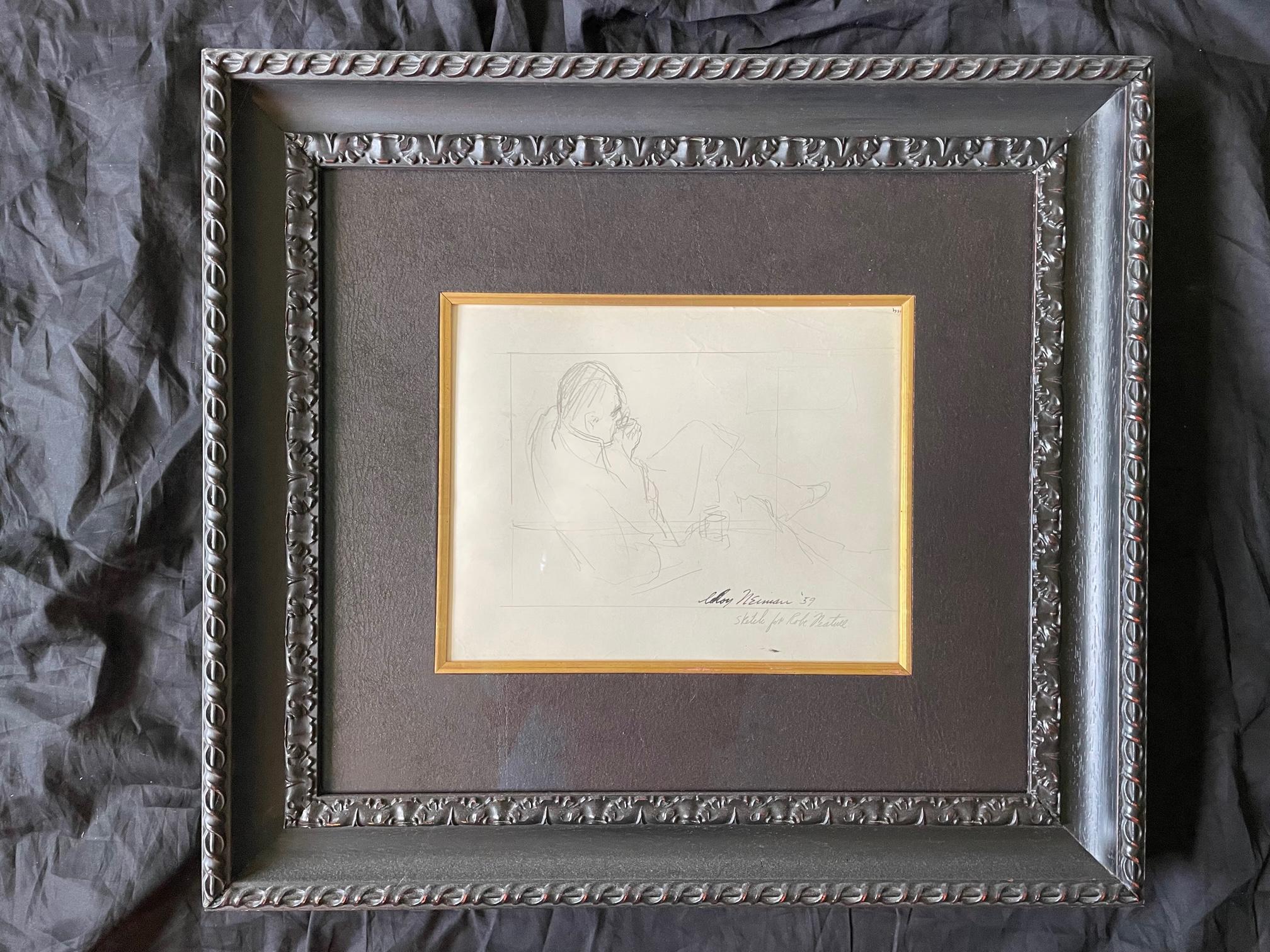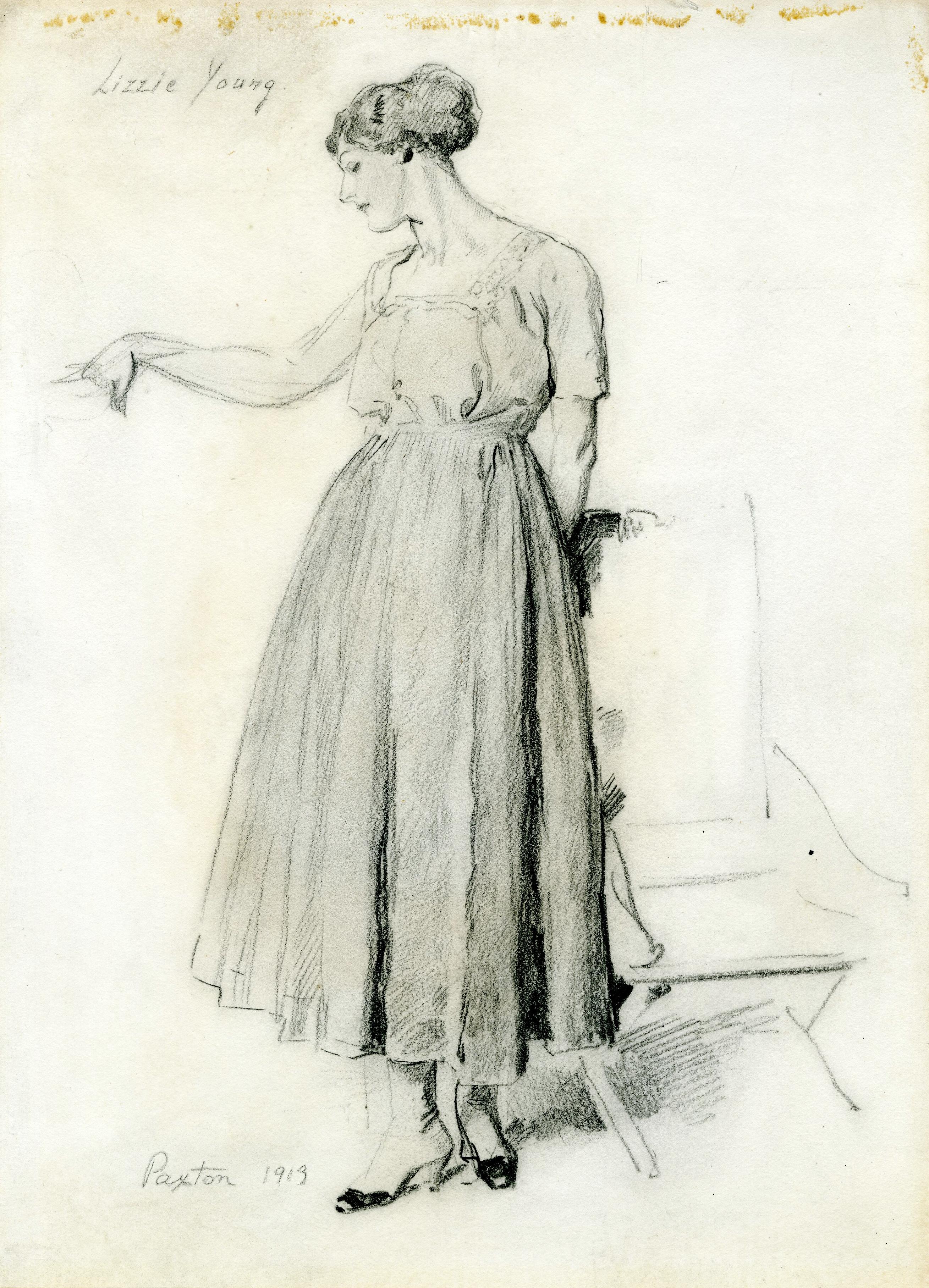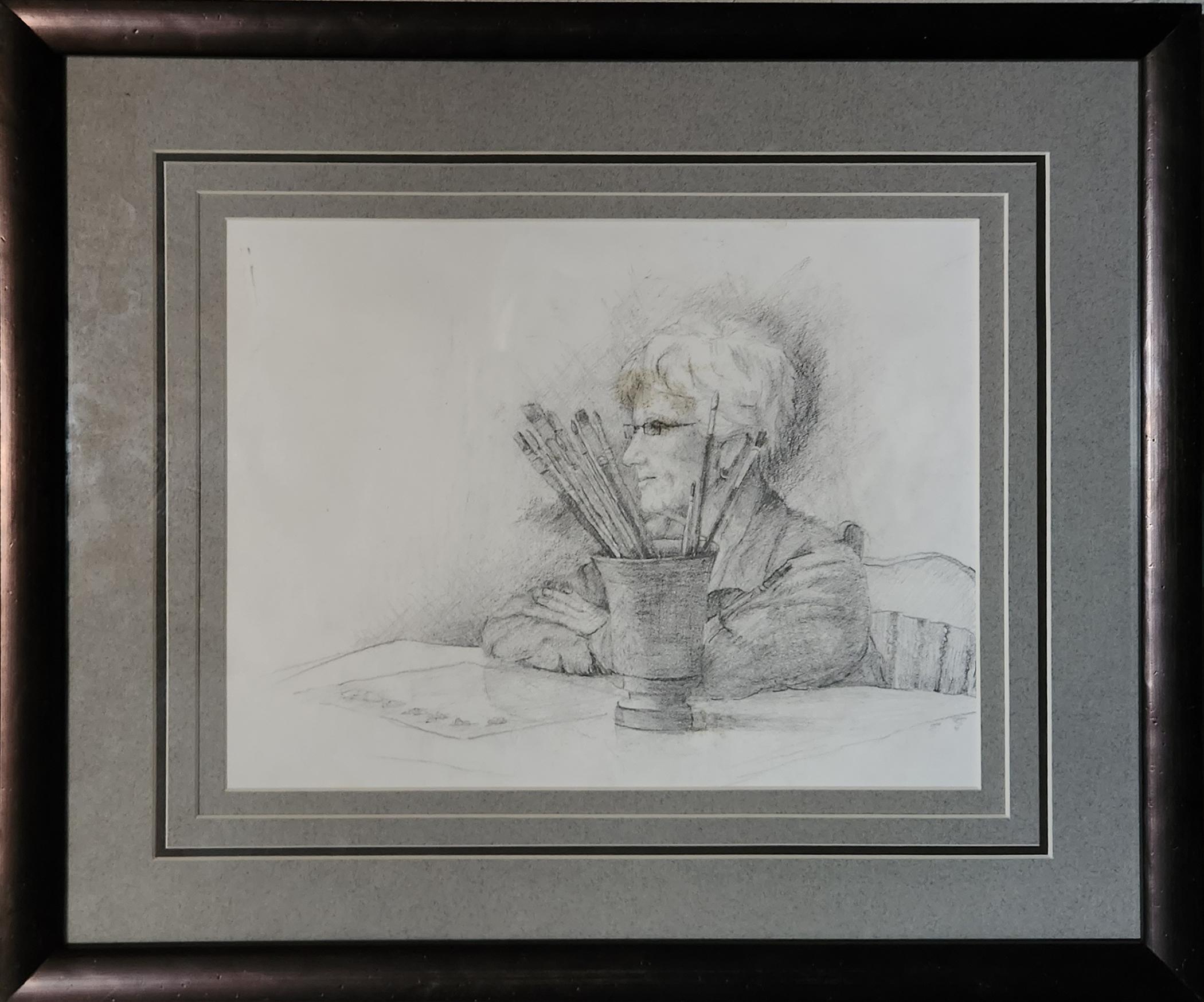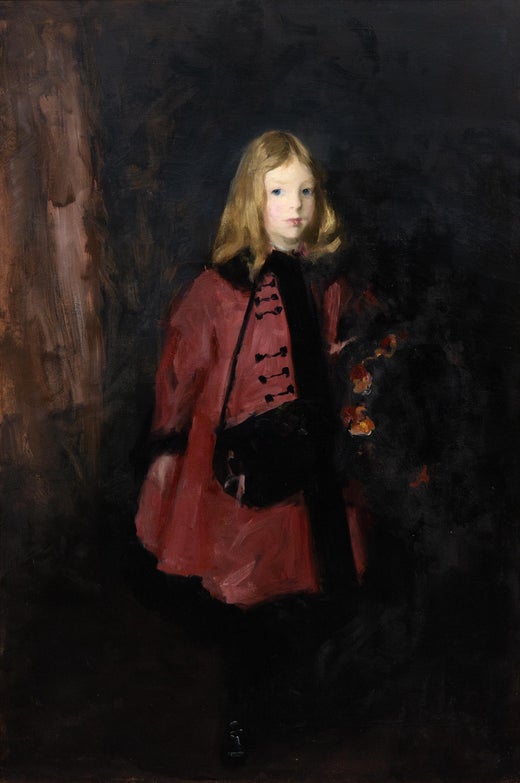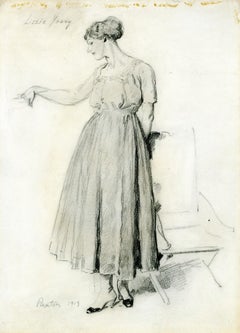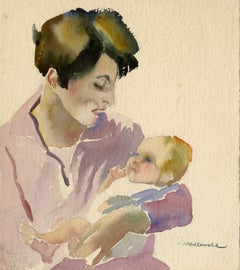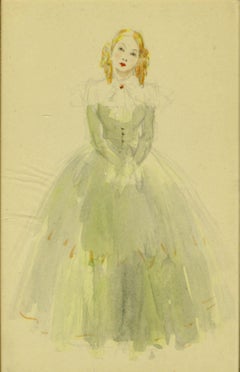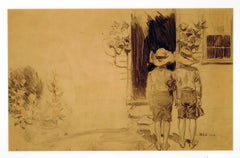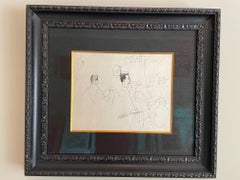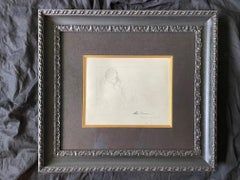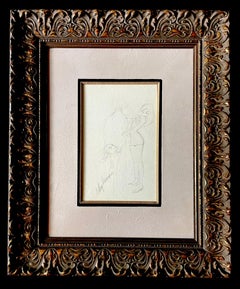Items Similar to Portrait of a resting young lady (Marjorie Organ)
Want more images or videos?
Request additional images or videos from the seller
1 of 6
Robert HenriPortrait of a resting young lady (Marjorie Organ)c. 1907
c. 1907
About the Item
Portrait of a resting young lady (Marjorie Organ)
Black chalk on paper. c. 1907
signed in ink by Henri's nephew, John C. LeClair, the executor of the Henri estate
"Robert Henri JLC"
Note: The sitter for this portrait is depicted in two drawings of similar size, illustrated in Chapellier Galleries Inc., Robert Henri 1865-1929, 1976, nos. 15 & 16.
Please see the attached photo of Marjorie Organ, Henri's second wife
Condition: Excellent
Image/Sheet size: 10 3/8 x 7 1/2 inches
Provenance: Estate of the Artist
John C. LeClair, Estate Adminitrator
Private Collection, Pawling, New York
Biography
Robert Henri was born Robert Henry Cozad in Cincinnati, Ohio, on June 24, 1865, the son of a professional gambler and real estate developer. The family lived in Nebraska and Colorado, but fled east when the father shot and killed a rancher over a land dispute and was indicted for manslaughter. They changed their last name because of the ensuing scandal and eventually settled in Atlantic City, New Jersey, during the early 1880s.
In 1886 Henri enrolled at the Pennsylvania Academy of the Fine Arts in Philadelphia, where he studied under Thomas Anshutz, Thomas Hovenden, and James B. Kelly. In 1888 he went to Paris and enrolled at the Académie Julian under William-Adolphe Bouguereau and Tony Robert-Fleury. During the summers he painted in Brittany and Barbizon, and he also visited Italy prior to being admitted to the École des Beaux-Arts in 1891. He returned to Philadelphia late that year, and in 1892 resumed studying at the academy. Henri initiated his long and influential career as an art teacher at the School of Design for Women, where he taught until 1895. During this period he met a group of young Philadelphia newspaper illustrators who, with Henri’s encouragement, would pursue painting careers in New York: John Sloan (American, 1871 - 1951), William Glackens (American, 1870 - 1938), George Luks (American, 1866 - 1933), and Everett Shinn (American, 1873 - 1953). He also made regular trips to Paris, where he was particularly influenced by the works of Edouard Manet (French, 1832 - 1883), Frans Hals (Dutch, c. 1582/1583 - 1666), and Diego Velázquez (Spanish, 1599 - 1660). In 1898 one of his paintings was purchased for the Musée Nationale du Luxembourg.
In 1900 Henri settled in New York. He taught at the New York School of Art (formerly the Chase School) from 1902 to 1908. He rejected both the genteel tradition of academic painting and impressionism, and instead created unconventional urban realist subjects executed in a bold, painterly style. Around 1902 he began to specialize in portraiture. In 1906 Henri was elected to the National Academy of Design, and that summer he taught in Spain. When the academy jury rejected works by Henri’s friends and colleagues—Sloan, Glackens, Luks, and Shinn—for its 1907 annual show, he resolved to organize an independent exhibition. The result was the famous show of The Eight that was held at Macbeth Gallery in February 1908. In 1910 Henri organized the first Exhibition of Independent Artists, an egalitarian group modeled after the Salon des Independents in Paris and operating under the principle, “no jury, no prizes.” Henri’s influence began to wane with the gradual ascent of more radical modernist styles after the 1913 Armory Show. Nevertheless, he continued to win numerous awards and taught at the Art Students League from 1915 until a year before his death from cancer on July 12, 1929.
Although Henri was an important portraitist and figure painter who was admired for his straightforward, vital likenesses of unusual sitters, he is best remembered today as the influential, progressive, and charismatic founder of the so-called Ashcan school of urban realism. A champion of “art for life’s sake,” he was noted for his democratic approach to portraiture, and chose sitters from diverse racial groups and walks of life. In 1909 he was strongly influenced by the color theories of Hardesty Maratta, and his palette brightened considerably. Henri was a tremendously influential teacher, and his ideas on art were collected by former pupil Margery Ryerson and published as The Art Spirit (Philadelphia, 1923).
Robert Torchia
Courtesy National Gallery of Art, Washington
- Creator:Robert Henri (1865-1929, American)
- Creation Year:c. 1907
- Dimensions:Height: 10.38 in (26.37 cm)Width: 7.5 in (19.05 cm)
- Medium:
- Movement & Style:
- Period:
- Condition:
- Gallery Location:Fairlawn, OH
- Reference Number:Seller: FA96111stDibs: LU14014663462
Robert Henri
Born Robert Henry Cozad, Robert shared a lineage with Mary Cassatt, making them cousins. Henri kept secret that relationship much as he did his birth name, in an effort to erase the reputation of a murder conviction against his father John Cozad. Robert's childhood reads like a Bret Harte short story. From card shark to real estate speculator, Henri's father moved the family from Cincinnati to Nebraska in a series of speculative land development projects. A disgruntled employee attacked Robert's father, and in self-defense his gun fired, killing the attacker. The murder conviction, later pardoned, led to the family's fleeing to Colorado, and assuming new identities. Robert Henri was sent to boarding school in New York, where he showed talent in writing and theater, creative endeavors encouraged by his mother. He discounted his creativity, thinking "artists surprised their parents... by doing masterpieces in their infancy... and [he] was not of that class" (Perlman). Nevertheless, painting buildings his father acquired in Atlantic City and producing political cartoons and color sketches for a small "museum" in his father's store caught the attention of admirers who encouraged Robert's art. James Albert Cathcart persuaded Henri to study at his alma mater, the Pennsylvania Academy of Fine Arts, where Henri enrolled in 1886. Robert Henri’s strong connection to the Pennsylvania Academy of the Fine Arts began when he enrolled as a student in 1886. He entered the Academy eight months after Thomas Eakins had resigned. Despite Eakins’s absence, his strong influence on the curriculum at PAFA remained and it affected Henri profoundly. Eakins had instituted new educational policies at the Academy that were some of the most progressive in the country. Thomas Anshutz played an important role in Henri’s development as an artist. He upheld many of Eakins’s ideas and continued to build upon his teaching method; however, Anshutz was also open to change and cultivated individual artistic expression. A devoted teacher, he did not impose artistic formulas. Henri valued Anshutz’s criticism greatly, and determined to succeed as an artist, he worked tirelessly as his student. After studying for three years in Paris from 1888 to 1891, Henri returned to Philadelphia and the halls of the Academy. Steeped in Anshutz’s call for realism and plain painting without bravura, Henri challenged himself and the other artists he influenced to “paint what you feel . . . paint what is real to you.” And so began his lifelong pursuit of painting “life in the raw,” without what he deemed “academic artifice.” He promoted this credo to his many students and perhaps popularized it most in his sensational 1908 exhibition at Macbeth Gallery, where he and a group of artists, eventually called The Eight, mounted a show that was a direct affront to the National Academy of Design’s rejection of their work and the modernist spirit that shaped them as artists. Henri met four of the artists who made up The Eight, William Glackens, John Sloan, Everett Shinn, and George Luks, in Philadelphia, where they all took classes at PAFA.
About the Seller
5.0
Recognized Seller
These prestigious sellers are industry leaders and represent the highest echelon for item quality and design.
Gold Seller
Premium sellers maintaining a 4.3+ rating and 24-hour response times
Established in 1978
1stDibs seller since 2013
791 sales on 1stDibs
Typical response time: 1 hour
Associations
International Fine Print Dealers Association
- ShippingRetrieving quote...Shipping from: Akron, OH
- Return Policy
Authenticity Guarantee
In the unlikely event there’s an issue with an item’s authenticity, contact us within 1 year for a full refund. DetailsMoney-Back Guarantee
If your item is not as described, is damaged in transit, or does not arrive, contact us within 7 days for a full refund. Details24-Hour Cancellation
You have a 24-hour grace period in which to reconsider your purchase, with no questions asked.Vetted Professional Sellers
Our world-class sellers must adhere to strict standards for service and quality, maintaining the integrity of our listings.Price-Match Guarantee
If you find that a seller listed the same item for a lower price elsewhere, we’ll match it.Trusted Global Delivery
Our best-in-class carrier network provides specialized shipping options worldwide, including custom delivery.More From This Seller
View AllPreliminary Study for the painting Rose and Gold, 1913
By William McGregor Paxton
Located in Fairlawn, OH
Preliminary Study for the painting Rose and Gold, 1913
Graphite on paper, 1913
Signed in pencil lower left (see photo)
Titlted "Lizzy Young" in pencil upper left (see photo)
Lizzy was a modle that Paxton depicts numerous times.
The painting that this drawing is related to, is illustrated in Lee & Krause, William McGregor Paxton, 1869-1941, Plate 32, text on page 132. The painting was formerly in the collection of Victor Spark and the Honorable Paul Buchanan. It is currently in a Texas Collection.
Provenance: Private Collection, Florida
William McGregor Paxton (June 22, 1869 – 1941) was an American painter and instructor who embraced the Boston School paradigm and was a co-founder of The Guild of Boston Artists. He taught briefly while a student at Cowles Art School, where he met his wife Elizabeth Okie Paxton, and at the Museum of Fine Arts School in Boston. Paxton is known for his portraits, including those of two presidents—Grover Cleveland and Calvin Coolidge—and interior scenes with women, including his wife. His works are in many museums in the United States.
Early life
He was born on June 22, 1869, in Baltimore to James and Rose Doherty Paxton. William's father moved the Paxton family and established a catering business in Newton Corner, Massachusetts, in the mid-1870s.
Education
Paxton attended Cowles Art School on a scholarship he attained at the age of 18. He studied with Dennis Miller Bunker...
Category
1910s American Impressionist Figurative Drawings and Watercolors
Materials
Graphite
Woman with child
By Robert Hallowell
Located in Fairlawn, OH
Woman with child
Watercolor on paper, c. 1930
Signed with the estate stamp lower right (see photo)
Exhibited: Marbella Gallery, New York
Illustrated: Robert Hallowell: An Artist Redi...
Category
1930s American Impressionist Figurative Drawings and Watercolors
Materials
Watercolor
Girl with the Golden Curls
By Everett Shinn
Located in Fairlawn, OH
Girl with the Golden Curls
Watercolor, c. 1895
Unsigned
Provenance: Davis Galleries, New York (see photo of label on reverse)
Condition: Mounted to support by the artist
...
Category
1890s American Impressionist Figurative Drawings and Watercolors
Materials
Watercolor
"And wasn't it good for a boy to be Out to old Aunt Mary's"
By Howard Chandler Christy
Located in Fairlawn, OH
"And wasn't it good for a boy to be Out to old Aunt Mary's"
Charcoal and watercolor on artist illustration board, 1900
Initialed and dated lower right: H.C.C. 1900 by the artist (see...
Category
Early 1900s American Impressionist Figurative Drawings and Watercolors
Materials
Charcoal
The Red Dress
By Robert Hallowell
Located in Fairlawn, OH
The Red Dress
Watercolor on paper, mounted on board by the artist, 1926
Signed and dated, 1926 lower left (see photo)
Condition: Mounted on support board by the artist
...
Category
1920s American Impressionist Figurative Drawings and Watercolors
Materials
Watercolor
Sketch of a woman's head in profile
By Sir William Orpen
Located in Fairlawn, OH
Sketch of a woman's head in profile
Graphite on paper, c. 1900-1910
Unsigned
Condition: Excellent
Tiny tear upper right near hinge (repaired and bearly visible)
Sheet size: 4 5/8 x 3...
Category
1910s Impressionist Figurative Drawings and Watercolors
Materials
Graphite
You May Also Like
Original Sinatra on the Set
By LeRoy Neiman
Located in Cumming, GA
Original Graphite and Pen Sketch on Paper
12 1/4″ x 15 5/8″ Viewable
26″ x 29 1/2″ Framed
Circa 1960’s
Category
1960s American Impressionist Figurative Drawings and Watercolors
Materials
Graphite
Original Richard Burton, The Robe Film
By LeRoy Neiman
Located in Cumming, GA
Original Graphite Sketch on Paper
1953 / Signed 1959
Inscribed “Sketch for Robe Feature”
10 5/8″ x 13 1/2″ Viewable
25″ x 29 1/2″ Framed
The Robe, a fictional Biblical epic film was ...
Category
1950s American Impressionist Figurative Drawings and Watercolors
Materials
Graphite
He Lost His Head Over Her
By LeRoy Neiman
Located in Cumming, GA
Original Graphite on Paper
Dimensions 12.5″ x 8″ Viewable
27″ x 22.5″ Framed.
Signed by Artist.
Circa 1962.
Category
1960s American Impressionist Figurative Drawings and Watercolors
Materials
Graphite
Planes of the Head, 10x8", pencil drawing, framed
By Lu Haskew
Located in Loveland, CO
Planes of the Head study by Lu Haskew
Pencil 10x8" image size
14x12" framed as pictured, behind glass
Graphite drawing.
Shipping price includes the custom packing necessary for safe...
Category
Early 2000s American Impressionist Figurative Drawings and Watercolors
Materials
Graphite
Self Portrait with Brushes, 9x11", pencil drawing, framed
By Lu Haskew
Located in Loveland, CO
Self Portrait with Brushes by Lu Haskew
Pencil 9x11" image size
15x18.5" framed as pictured, behind glass with archival matte
Graphite drawing of the artist with her tools
Shipping ...
Category
Early 2000s American Impressionist Figurative Drawings and Watercolors
Materials
Graphite
Planes of the Head
By Lu Haskew
Located in Loveland, CO
"Planes of the Head" by Lu Haskew
Graphite on Paper 14x12" framed, 10x8" image size
ABOUT THE ARTIST:
Lu considered it a must to work with live models once ...
Category
Early 2000s American Impressionist Figurative Drawings and Watercolors
Materials
Archival Paper, Graphite
